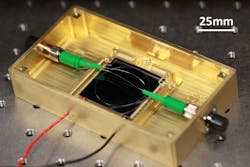Gyroscope designs used in inertial navigation systems (INS) fall into three basic groups: the classic spinning-rotor mechanical gyro (still in use in specialized situations due to its superior performance capabilities); the optical-based laser gyro using either a mirrored, close-loop path or a lengthy, coiled optical fiber (capable of very high performance, but with substantial weight and size); and the MEMS device (small, light, and low power, with lesser—yet still very good—performance).
Now, a team based at the California Institute of Technology (Caltech) has devised, analyzed, built, and tested a laser-based gyro that also leverages the unique capabilities of microelectromechanical-systems (MEMS) technology (but not a MEMS-gyro core) for some of its internal components. Thus, it provides optical-gyro-class performance but in a more compact and lighter package. The unit exhibits high sensitivity and can even accurately measure the rotation of the Earth, considered to be one of the more stringent performance tests.
It’s so notable that the accomplishment is cited in the title of their technical paper “Earth rotation measured by chip-scale ring laser gyroscope” published in Nature Photonics. Prof. Kerry Vahala, Ted and Ginger Jenkins Professor of Information Science and Technology and Applied Physics, noted that "For more than 20 years, researchers have speculated about placing optical gyroscopes onto a chip very much like the highly successful MEMS gyroscopes. But until recently, there have been very few compelling experiments."
As with all optical gyros, the Caltech device is based on the well-known Sagnac effect, in which a single optical beam is split and sent on counter-rotating paths back to a single optical sensor (Fig. 1). The two interfering waves are then compared and the phase shift between them characterizes the acceleration as determined by relativistic principles.
In this implementation, the pathway for the laser light is a circular silica disk resonator with clockwise and counterclockwise stimulated Brillouin laser (SBL) scattering via optical pumps using high-frequency vibrations in the disk (Fig. 2). Although the shorter light path in this gyroscope helps to keep the device smaller, it could also result in lower sensitivity. To make up for that, the light is "recycled," says Yu-Hung Lai, co-author on the paper. "The light is allowed to circulate around the path again and again, creating a stronger Sagnac effect and greater sensitivity to rotation.
For the optical-cavity resonator that controls the optical pumping modes, the team used precise microfabrication to create the microresonator as a 36-mm silica wedge with free-spectral resonance of 1.808 GHz and extreme Q factor above 100 million. The resonator is packaged in a small metal box with optical-fiber connections and thermal stabilization, almost always a necessity in these precision laser and optic installations (Fig. 3).
Assessing the performance of a precision gyroscope is a complicated affair with many error parameters. It must be done with various corrections and compensations for known sources of error and nonlinearities. In addition to basic “static” test of short-term noise and longer-term performance, the team installed their unit on an air-bearing rotation stage. They aligned the stage and gyroscope normal to the plane of the stage, which was tilted to the angle of the local latitude (34.1 degrees in Pasadena, Calif.) relative to the Earth’s axis for one set of data, then rotated the assembly 90 degrees to eliminate the Earth’s rotation from the axis of sensitivity for orthogonal data.
It’s not practical to summarize performance with a single number or even a few, but they reported the performance was comparable to some of the best gyroscopes available with respect to sensitivity, accuracy, bias instability, noise, and drift, and identified potential areas of further refinement with an ambitious goal of 10X improvement. They noted that the all-solid-state design and its integration of the photonic and electronic components are appealing for both robust operation and scalable manufacturing, although they also acknowledge that the device isn’t yet ready for commercialization.
In addition to the posted technical paper, they posted Supplementary Information that includes a table comparing key specifications of this unit to other announced micro-optical gyros. It also includes several pages of truly intense math that analyzes some of the dominant error sources. Funding for the research was provided by the Defense Advanced Research Projects Agency (DARPA).
About the Author

Bill Schweber
Contributing Editor
Bill Schweber is an electronics engineer who has written three textbooks on electronic communications systems, as well as hundreds of technical articles, opinion columns, and product features. In past roles, he worked as a technical website manager for multiple topic-specific sites for EE Times, as well as both the Executive Editor and Analog Editor at EDN.
At Analog Devices Inc., Bill was in marketing communications (public relations). As a result, he has been on both sides of the technical PR function, presenting company products, stories, and messages to the media and also as the recipient of these.
Prior to the MarCom role at Analog, Bill was associate editor of their respected technical journal and worked in their product marketing and applications engineering groups. Before those roles, he was at Instron Corp., doing hands-on analog- and power-circuit design and systems integration for materials-testing machine controls.
Bill has an MSEE (Univ. of Mass) and BSEE (Columbia Univ.), is a Registered Professional Engineer, and holds an Advanced Class amateur radio license. He has also planned, written, and presented online courses on a variety of engineering topics, including MOSFET basics, ADC selection, and driving LEDs.



